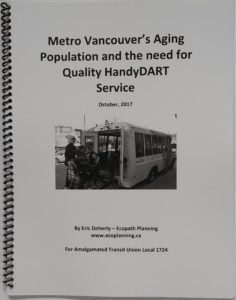Metro Vancouver’s Aging Population and the need for Quality HandyDART Service (October 2017)
 Metro Vancouver’s Aging Population and the need for Quality HandyDART Service shows how present service levels are grossly inadequate, and how the need is growing faster than ever now that the boomers are entering their 70s. It documents the poor track record that for-profit corporations have for service quality, and suggests operating HandyDART as a subsidiary of TransLink.
Metro Vancouver’s Aging Population and the need for Quality HandyDART Service shows how present service levels are grossly inadequate, and how the need is growing faster than ever now that the boomers are entering their 70s. It documents the poor track record that for-profit corporations have for service quality, and suggests operating HandyDART as a subsidiary of TransLink.
HRA Backgrounder – Transit Referendum & HandyDART Dec 2014
Media backgrounder on the transit referendum and HandyDART
HandyDART Riders’ Alliance proposal for HandyDART service hours (March 2014) 
TransLink increased HandyDART service hours by about 5% per year between 2002 and 2008 to keep up with demand. Between 2008 and 2013 service hours were frozen and HandyDART trip denials soared. Three 80,000 hour increases, each costing about $7 million or 0.5% of TransLink’s present budget to operate, is needed to catch up after five years without an increase. After that, smaller regular increases will be needed to keep up with growing demand.
X
Metro Vancouver’s Aging Population and the Need for Improved HandyDART Service (November 2013)
Over the last five years the number of people over 70 in Metro Vancouver has increased by two and a half times that of the general population. Metro Vancouver’s Aging Population and the Need for Improved HandyDART Service documents how the ongoing increase in older seniors will translate into a greater number of people with disabilities and a resulting need for quality HandyDART service.
X
Engaging the Future: Making HandyDART a TransLink Subsidiary. Prepared by Ann Vrlak for the Coalition of handyDART Users (2005)
This report concludes that a single, TransLink subsidiary for custom transit would enable:
- A bigger and better service for people with disabilities and seniors.
- A host of ways for TransLink to cut costs, improve operations and long-term plan.
- Employees to have job stability, better working conditions, more training and incentives for extended employment.
